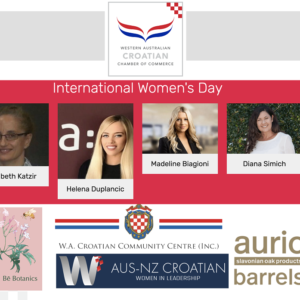The largest portion of the Croatian diaspora lives in Germany, which happens to be the largest country within the European Union. Almost half a million people with Croatian passports as well as several hundred thousand with Croatian ancestry who have received German citizenship and their descendants reside permanently in Germany. Croats are almost ideal immigrants: loyal, calm, hardworking, enterprising. Croats are known not to cause problems, the crime rate among them is low when compared to the rest of German population. It is no different in Croatia either. The crime rate in Croatia is the lowest in Europe and this becomes evident to the 3.3 million German tourists that visit Croatia regularly. The average German, therefore, does not have even the slightest of reasons to be suspicious of Croats as potential causers of unrest.
Croats in Germany are not only employees, but also entrepreneurs, especially in construction and gastronomy. Jure Vujcic has been running the restaurant “Marjan Grill” in Berlin since 1981. The restaurant is doing so well that you can only get a table by reservation. Adi Cerimagic, a Bosniak activist employed at ESI (European Stability Initiative), was among the restaurant’s numerous guests late last year. According to its own statement ESI advocates for democratic institutions and human rights. There is a justified suspicion that for ESI or employees thereof these ESI noble intentions do not apply to Croats; this is demonstrated by the ESI attitude towards the controversies in Bosnia and Herzegovina, where it openly advocates a pro-Bosniak and anti-Croatian position.
In his own words, Cerimagic warned the owner of the restaurant about the Croatian coat of arms on the front of the building. In his opinion, such a coat of arms is not permitted, because, he says, it is “Ustashe”, so it should be removed. The restaurant owner did not agree with that because it is a historical Croatian coat of arms that has been used continuously for over 500 years. Hence, no social group can have an exclusive right to it. Much like the Swiss cross. Cerimagic passed on his understanding of the coat of arms to Michael Martens, a correspondent of the “Frankfurter Allgemeine Zeitung” (FAZ) newspaper for Southeast Europe, who proceeded to use it as a topic for one of his newspaper articles. Martens has a reputation of being a journalist of good quality and experienced who spent many years in Serbia (which harbours relentless enmities against Croats and Croatia) where he learned a lot of bad things about Croats and Croatia. Hence, in his occasional articles about Croatia, Martens mainly presents well-known Serbian stereotypes that are not anchored in facts nor have a foothold in facts.
Based on such attitudes, being a Croat is suspicious in itself, and if a larger group of Croats celebrates a sporting success together with their favourite singer, then it is absolutely reprehensible, even if there are no riots. Martens dismisses an argumentative reply as the work of a right-wing extremist.
Martens accepted Cerimagic’s recommendation and wrote an article entitled “Restaurant Review” (“Restaurantkritik”, 10.03.23), which is less of a restaurant review and more of a criticism of Croatian society and especially of Croats in Germany like Vujcic, who are supposedly pro-fascist and not even aware of it.
At the same time, Martens stays in the background with his judgment and gives the floor to university professors Ivo Goldstein (Zagreb), Florian Bieber (Graz) and Alexander Korb (Leicester), who seem to be competing against each other as to who will give a more severe criticism.
The essence of their criticism is that the Croatian red and white checkerboard coat of arms, which begins with the white field as the first field on the checkerboard, belongs exclusively to the Ustashas. The Ustashe were the military police formation in the World War Two Independent State of Croatia (NDH) created by Hitler in 1941 on the ruins of the Kingdom of Yugoslavia, who established his government in it, which carried out his orders, such as the enforcement of racial laws.
The fact is that some Ustashas committed terrible crimes while others resisted committing crimes. This resulted in at least a quarter of the pre-war Jewish population being saved in the NDH even though Hitler’s strictest of orders were to exterminate them all. There are few such examples in Europe from the Second World War. There is a book about this based on archival material and authored by Esther Gitman: “When Courage Prevailed: The Rescue and Survival of Jews in the Independent State of Croatia 1941–1945”. I gifted Martens a copy of this book 4 years ago but it seems he hasn’t even read it. Meanwhile, almost no Jews survived in Serbia, which had a state administration similar to that of the NDH. Already in 1942, Serbia declared itself “judenfrei” (Jew free). Evidently, Martens does not care about this nor does this fact appear to interest him.
Goldstein comes from a hardline Yugoslav Communist family. There are several vanquishing reviews about his work, for example by Dr. Vladimir Geiger: “In his latest book ‚Jasenovac‘ Goldstein showed neither ‚good will‘ nor ‚common sense‘. On the contrary, he continues to lobotomise us by expressing everything but the willingness and ability to engage in scientific approach.”
When Goldstein says: “There is no doubt that anyone who today uses the checkerboard that begins with a white field declares himself a neo-Ustasha,” a serious analyst, such as Martens who is being portrayed as such, would have to interpret this as something like this: “Whoever uses a checkerboard that begins with a white field today shows himself to be a free-thinking man, who is not interested in the servings dished out by the Yugoslav communists”.
Goldstein is known to be a fan of the communist dictator Tito and he kept his portrait in his office while serving as the Croatian Ambassador to France in Paris from 2012. Despite being a supporter of one totalitarianism, as far as the Frankfurter Allgemeine Zeitung newspaper is concerned, he has become qualified enough to judge another totalitarianism!?
In a television interview in 2018, he claimed that in March 1945, for the purposes of hiding their crime the Ustashe received a special corpse crushing machine from Germany with which they grounded and crushed the corpses of their victims. That statement, which he did not repeat again, and whose accuracy could not be confirmed by anyone else, earned him the appropriate nickname “the Crusher”.
Florian Bieber, known among other things for having signed the so-called The Sarajevo declaration on a common language, according to which Serbian and Croatian are one and the same language, and therefore Croatian, one of the languages of the European Union (!), does not exist at all. Matica Hrvatska, the leading Croatian cultural organization, considers this Declaration to be linguistic violence. Bieber says:
“A coat of arms with a white field at the beginning indicates support for the Ustasha regime or are right-wing extremist groups. The use of a checkerboard with a white field is clearly associated with a right-wing extremist meaning.”
With this categorical statement professor Bieber shows all his superficiality and ignorance. Obviously, he has never had in his hands the 1974 Constitution of the SFRY (Socialist Federative Republic of Yugoslavia) which prescribes a checkered coat of arms with an initial white field for the then Socialist Republic of Croatia, a component of Yugoslavia. Following his statement, Tito supported the Ustasha regime in the last years of his life.
Evidently unaware of its consequences, Alexander Korb, a Holocaust professor in Leicester, England, makes the most drastic, albeit true, statement:
“The use of symbolism is primarily a signal that the ‘Independent State of Croatia’ from 1941 to 1945 is considered a historically legitimate project.”
This is precisely the position that Martens persistently expresses, and it originates from Greater Serbia Serbs and Yugoslav communists: “Since Adolf Hitler in 1941, with his spontaneous decision, fulfilled the centuries-old dream of many generations of Croats and established a Croatian state, it, like Hitler, would have to disappear and remain permanently banned! All Croats must suffer for all eternity because a group of Croats abused the power that was suddenly granted to them by Hitler in April 1941.”
The checkered Croatian coat of arms originates from Austria in 1495. Although heralds claim that it should start with the first red field, which symbolises gold, which is more valuable than silver (white field), it seems quite natural that both variants are used simultaneously.
The coat of arms in question was used in all countries where Croats had some form of identity (Austria, Austria-Hungary, Kingdom of Yugoslavia, Independent State of Croatia, SFR of Yugoslavia). There is also an opinion on this from the Ministry of Foreign and European Affairs of the Republic of Croatia, which Martens unfortunately failed to request it seems:
“The historic Croatian coat of arms with a red and white checkerboard has existed for centuries in both heraldic forms, with an initial red or white field at the top left. Both forms are used today in Croatia as symbols on buildings or in associations. From the point of view of the Republic of Croatia, this coat of arms cannot be viewed as an anti-constitutional symbol, because it, as a free-standing symbol without additions, refers to belonging to Croatian culture and identity, and in no way to the military formations of totalitarian regimes.”
Several books have been published about the Croatian checkered coat of arms, for example Dr. Mario Jareb’s 2022 book: “From Checkerboard to Tricolor: Development and Use of the Croatian Coat of Arms and Flag Throughout the Centuries”. If only Martens and his interlocutors had taken a brief look at it, an article like the one mentioned above would probably not have been written. Dr. Jareb himself writes in an article: “Coats of arms and flags without the Ustasha tendril are not NDH coats of arms and flags.” Therefore, the insinuation that the flag which contained the coat of arms with the initial white field, with which the then Croatian president Kolinda Grabar Kitarovic took a picture with a group of Croatian emigrants in 2016, is “Ustasha”, is baseless. By the way, during the Second World War, the Ustashe movement did not have its own flag at all, so there was never an Ustasha flag.”
In the end, the question remains open as to why the Government of the Republic of Croatia did not regulate the issue of the Croatian checkered coat of arms in an appropriate manner (at least with a decree). Considering that the Independent Democratic Serbian Party (SDSS), which emerged from the Serbian rebels, who terrorised the Croats during the 4 years of war in 1991-95, and today are trying to realise their war goals with peacetime means. The passive attitude of the Government is also represented in the parliamentary majority is not surprising, although it is by no means acceptable, and is absolutely reprehensible. As long as this is the case, further attacks on Croatian national symbols can be expected.
The combination of red and white squares can be found in many patterns in Croatia, especially in sports. Designer Boris Ljubicic created many applications on that basis. Among them is our logo, which according to the logic of Martens & Co, should also be banned, because it starts with the first white field.
The Croatian checkered coat of arms is so widespread among Croats around the world that some form of state protection of origin and authenticity would be necessary. Outbursts like this article in the “Frankfurter Allgemeine Zeitung” are the best proof of that. It is fortunate that German readers do not read or believe articles like this one.
It is unfortunate that FAZ, once a very respectable newspaper, allows the publication of articles that exude the spirit of Greater Serbian, Yugoslav-Communist enviers and charlatans in line with the principle: “Call M.M. when you want to smear Croatia.”
dr. Josip Stjepandic
President of the Croatian Academy of Sciences and Arts in Diaspora and Homeland





